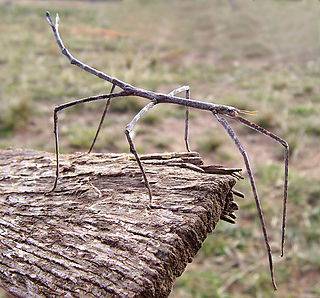
The Phasmatinae are a subfamily of stick insects in the family Phasmatidae. They contain at least three tribes; Bradley and Galil corrected the spelling to "Phasmatinae" and provides a key to tribes.
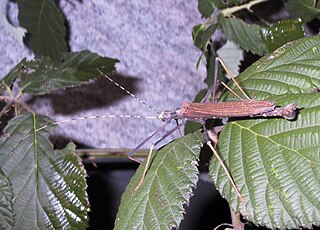
Pseudophasmatidae is a family of stick insect, in the suborder Verophasmatodea, commonly called the "striped walkingsticks". An important identifying characteristic is its mesothorax, which is never more than three times as long as the prothorax.

Necrosciinae is a subfamily of the stick insect family Lonchodidae, with its greatest diversity in South-East Asia.
Asceles is a genus from the stick insect family Diapheromeridae. Some of the species of Asceles have a distribution in Malaysia and Singapore.

Bacillidae is a stick insect family in the order Phasmatodea and the suborder Verophasmatodea.

Bactrododema is a genus of the stick insect family Diapheromeridae. Species of this genus have a relictual distribution and are endemic to southern Africa.

Aschiphasmatidae are a family of stick insects belonging to the suborder Verophasmatodea; they can be found in Indomalaya.
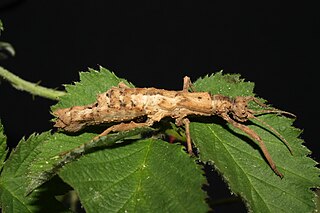
The Heteropterygidae is a family of stick insects belonging to the suborder Verophasmatodea; species can be found in Australasia, East and Southeast Asia.

Diapheromerini is a tribe of walkingsticks in the family Diapheromeridae. There are at least 30 genera Diapheromerini.
Oxyartes is a genus of stick insects in the family Diapheromeridae and subfamily Necrosciinae; species records are from India through to Indochina.
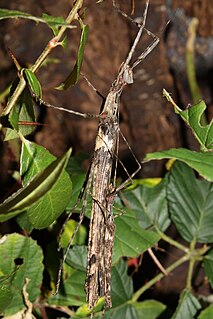
Trachythorax is an Asian genus of stick insects in the family Diapheromeridae and subfamily Necrosciinae. Species have been recorded from the Indian subcontinent, Indo-China, Malesia through to New Guinea.

Necroscia is an Asian genus of stick insects in the family Diapheromeridae and subfamily Necrosciinae. Species have been recorded from South-East Asia.
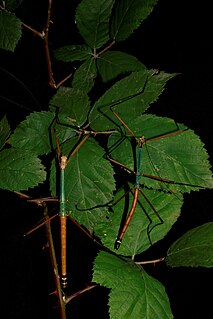
Lopaphus is an Asian genus of stick insects in the family Diapheromeridae and subfamily Necrosciinae. Species have been recorded from India, China and South-East Asia.

Pachymorphinae is a subfamily of stick insects in the family Diapheromeridae. Genera are primarily found in Africa, Asia and Australia.

The Lonchodinae are a subfamily of stick insects in the family Lonchodidae found in: Australasia, Asia, Africa, Southern America and the Pacific.
Ramulus westwoodii is a species of stick insect first described by James Wood-Mason in 1873 and named in honour of John O. Westwood.

Achrioptera is a genus of stick insects first described in 1861. It is one of two genera in the tribe Achriopterini, the other being Glawiana. Species in the genus Achrioptera occur in Africa, including Madagascar. Although they are brightly colored, members of Achrioptera are able to effectively mimic thorny twigs and sticks for camouflage.

Phasmatini is a tribe of stick insects in the family Phasmatidae. There are more than 40 described species, found in Australasia, Asia and possibly Brazil.

The Platycraninae are an anareolate subfamily of stick insects in the family Phasmatidae. Their known distribution includes southern, southeast Asia and Australasia.

The Megacraniinae are an anareolate subfamily of stick insects in the family Phasmatidae. Their known distribution includes Malesia and islands in the Pacific and Indian oceans. Several genera have been revised and were placed previously in the Platycraninae.
















